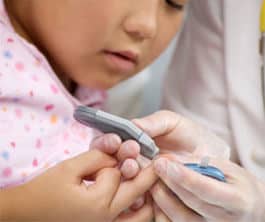In 2009, the American Diabetes Association (ADA) recommended that Hemoglobin A1c be exclusively used for the diagnosis of diabetes in children. The simple test measures longer-term blood sugar levels — without requiring patients to fast overnight. However, a new U-M study has shown that these tests are not very accurate in children.
“We found that Hemoglobin A1c is not as reliable a test for identifying children with diabetes or children at high risk for diabetes compared with other tests in children,” says Joyce M. Lee, M.D., M.P.H., lead author of the study and a pediatric endocrinologist at U-M’s C.S. Mott Children’s Hospital. “In fact, it failed to diagnose two out of three children participating in the study who truly did have diabetes.”
A previous study released earlier this year, also by Lee, found that hemoglobin A1c is not as reliable a test for identifying children with diabetes and pre-diabetes compared with adults.
Although tests that require patients to fast are the most accurate tests, they are difficult to obtain in clinical practice, highlighting the need for improved nonfasting testing strategies.
Due in part to high rates of childhood obesity, the Centers for Disease Control estimates that approximately 2.5 million children in the U.S. currently qualify for diabetes screening.
The study, published online ahead of print in the journal Diabetes Care, tested 254 overweight children using both fasting and non-fasting methods. Researchers found that the recommended test, Hemoglobin A1c, missed more cases of pre-diabetes or diabetes compared to other tests.
Participants in the study were defined as having prediabetes or diabetes based on a gold standard test. They were first tested using the Hemoglobin A1C test. After fasting for 12 hours, they returned on a separate day and were tested using a fasting method.
Based on the results, researchers urge that a nonfasting one-hour glucose challenge test, or a random glucose, may be promising methods for identifying children with prediabetes or diabetes.
“Other pediatric organizations, like the American Academy of Pediatrics, have not endorsed the use of HbA1c yet. However, there is concern that should they endorse it, more and more providers would use these testing methods, leading to an increase in missed diagnoses in the pediatric population,” says Lee.
Researchers intend to use their data to drive future recommendations about screening for diabetes.
“We are currently studying whether the promising nonfasting tests, including the 1-hour glucose challenge test or the random glucose, could be used in combination with clinical characteristics to better identify which children have prediabetes or diabetes,” says Lee.
For the full Diabetes Care article, please click here.
If our reporting has informed or inspired you, please consider making a donation. Every contribution, no matter the size, empowers us to continue delivering accurate, engaging, and trustworthy science and medical news. Independent journalism requires time, effort, and resources—your support ensures we can keep uncovering the stories that matter most to you.
Join us in making knowledge accessible and impactful. Thank you for standing with us!


Be aware of drugs that potentiate diabetes.
Eli Lilly Zyprexa Olanzapine issues linger.
The use of powerful antipsychotic drugs has increased in children as young as three years old. Weight gain, increases in triglyceride levels and associated risks for diabetes and cardiovascular disease. The average weight gain (adults) over the 12 week study period was the highest for Zyprexa—17 pounds. You’d be hard pressed to gain that kind of weight sport-eating your way through the holidays.One in 145 adults died in clinical trials of those taking the antipsychotic drug Zyprexa.
This was Lilly’s #1 product $5 billion per year sales,moreover Lilly also make billions more on drugs that treat diabetes.
— Daniel Haszard Zyprexa victim activist and patient.
FMI zyprexa-victims(dot)com